(Headline USA) Under assault by woke gender-bender policies, misguided vaccine mandates and international turmoil caused by the Biden administration’s disastrous foreign policy, soldiers are leaving the Army National Guard at a faster rate than they are enlisting.
The exodus has sparked concerns that in the coming years units around the country may not meet military requirements for overseas and other deployments.
For individual states, which rely on their Guard members for a wide range of missions, it means some are falling short of their troop totals this year, while others may fare better. But the losses comes as many are facing an active hurricane season, fires in the West and continued demand for units overseas, including combat tours in Syria and training missions in Europe for nations worried about threats from Russia.
According to officials, the number of soldiers retiring or leaving the Guard each month in the past year has exceeded those coming in, for a total annual loss of about 7,500 service members. The problem is a combination of recruiting shortfalls and an increase in the number of soldiers who are opting not to reenlist when their tour is up.
The losses reflect a broader personnel predicament across the U.S. military, as all the armed services struggled this year to meet recruiting goals. And they underscore the need for sweeping reforms in how the military recruits and retains citizen soldiers and airmen who must juggle their regular full-time jobs with their military duties.
Maj. Gen. Rich Baldwin, chief of staff of the Army National Guard, said the current staffing challenges are the worst he’s seen in the last 20 years, but so far the impact on Guard readiness is “minimal and manageable.”
“However, if we don’t solve the recruiting and retention challenges we’re currently facing, we will see readiness issues related to strength begin to emerge within our units within the next year or two,” he said.
According to Gen. Daniel Hokanson, head of the National Guard Bureau, both the Army and Air Guards failed to meet their goals for the total number of service members in the fiscal year that ended last Friday. The Army Guard’s authorized total is 336,000, and the Air Guard is 108,300.
Baldwin said the Army Guard started the year with a bit more than its target total, but ends the fiscal year about 2% below the goal. Fueling that decline was a 10% shortfall in the number of current soldiers who opted to reenlist. Hokanson said the Air Guard missed its total goal by nearly 3%.
While the shortfalls for 2022 may be small percentages, the Guard is facing increasing losses over the next year due to the U.S. military’s requirement that all troops get the COVID-19 vaccine. Currently about 9,000 Guard members are refusing to get the shot, and another 5,000 have sought religious, medical or administrative exemptions.
So far, no Guard members have been discharged for refusing the vaccine order. The National Guard is awaiting final instructions from the Army on how to proceed. Officials have said it’s not clear when they will get that guidance.
With more losses likely on the horizon, Guard leaders are looking for ways to entice service members to join or reenlist. Hokanson said a critical change would be to provide Guard members with healthcare coverage. Currently, he said, about 60,000 Guardsmen don’t have health insurance. And those who have insurance through their civilian employer have to go through a difficult process to move to the military’s TRICARE program when they are on active-duty status.
The cost of providing health care coverage to those who don’t have it would be about $719 million a year, he said.
Other changes that could help, he said, would include expanding educational benefits and giving Guard members a financial bonus when they bring in new recruits. Such bonuses were used during the peak of the Iraq and Afghanistan wars, but there were some problems that Hokanson and others said could be avoided now.
Adapted from reporting by the Associated Press

